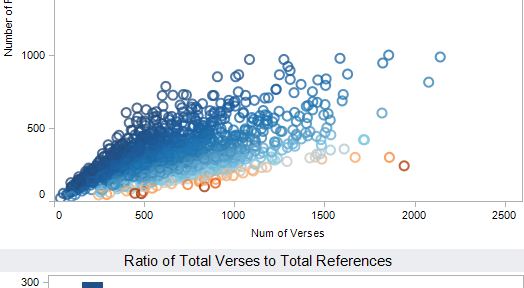The Christian scriptures are interconnected in deep and meaningful ways which can sometimes be hard to discover. Scholars have compiled hundreds of thousands of cross-references over time, and modern computer whizzes have charted these references in beautiful and engaging displays. I have taken a new approach, which you can see below. It displays three measures: the number of verses in each chapter, the number of cross references in each chapter, and the ratio between the two.
In a moment I will share a few examples of the insights this visualization affords, but first I’ll explain how I arrived at the idea for making this particular interactive tool. I began working several months ago to compile available data into what I call MetaV. The eventual goal is to link descriptive information to every word in the Bible and to help users interact with it in such a way that they can see the “big picture” of any passage, including people, places, things, and even cross-references. Naturally, this led me to google “bible cross reference data.” Hit #1: Chris Harrison’s visual showing over 63,000 references with colors indicating the canonical distance between the chapters and bars showing the length of each chapter.
Immediately, I was hooked on it. I’ll confess: it still graces the background of my computer desktop. The reason I was so mesmerized is that he has packed a lot of information into a display that is simple at first glance then grows more complex and informative as you zoom in. It conveys the fact that the Bible is an interconnected whole. The density in some areas gives a general sense of which books may be interesting to us because they were meaningful enough for many other books to refer to it. And that nice, long, thin line towards the middle representing Psalm 119 just begs for attention while happily providing an axis of symmetry. It is art that fulfills it designer’s stated goal:
…we set our sights on the other end of the spectrum –- something more beautiful than functional. At the same time, we wanted something that honored and revealed the complexity of the data at every level –- as one leans in, smaller details should become visible.
Mr. Harrison was kind enough to get me in touch with his collaborator, Christoph, who in turn provided the data behind the graphic (which had been updated to include over 80,000 records). Yet, I was also aware that this many cross references might not be enough for me. Further searching brought me to two more visualizations of a much larger data set – over 340,000 cross references. The first is from OpenBible.info, the same site which is the source for my Bible Places explorer. The second is found on the ESV Blog. Both of these are interesting in their complexity and verse-level detail, which adds a degree of information not contained in Chris Harrison’s work. However, they both have a lot of redundancy – one could easily cut the visuals in half and get just as much information.
All of these are more useful in terms of artwork than for visual analysis and in-depth exploration. My expertise is in crunching numbers, not so much in making beautiful displays of them. I wanted to modify the idea of graphing hundreds of thousands of pieces of information in a way that makes certain aspects of it stand out. Just to make it a challenge, I combined the two data sets I found into one massive table containing 412,100 references once I filtered out duplicate records. The outliers you see above are chapters of the Bible which stand out here but would be lost in the haystack within the visualizations I’ve mentioned. While mine is nothing more than an interactive version of common graphical displays, it makes it easy for our eyes and minds to identify interesting points.
Right away, you can see that Psalm 119 lies lonely at the top-right because it is by far the longest chapter of the Bible and consequently has the most cross-references related to it. The orange circles stand in contrast because they have proportionately fewer cross references than other chapters. We might expect those to be the ones which are nothing more than long, detailed genealogical records. Two of the noticeable outliers fits that expectation (1 Chronicles 7&8) , but the others do not.
1 Chronicles 3, the brightest orange circle, is the chapter which details the construction of Solomon’s Temple. Exodus 36&37, two other orange marks, give specifics about making the Tabernacle and the Ark of the Covenant. The dimensions and construction materials of these things are rife with metaphors. Perhaps their symbolism is linked to other portions of scripture in ways we do not yet know an have not catalogued, or maybe they should continue to stand alone due to their uniqueness. On the other end of the spectrum, Romans 12 has more cross references for each verse than any other chapter. When you read it, you’ll understand why. On average, every single verse has more then one reference associated with it. In all, 77 chapters of the Bible fir in that same category.
These are just some of the things that can lead a student of the Lord to discover more about him. We can search out the things we may normally pass over but which stand out in an analysis such as this. What can you find by searching through, selecting, and zooming in on these plots? What might you learn that you would otherwise overlook? Please leave a comment if you happen upon something interesting or the Lord blesses you in some way as a result of your studying these visuals.


One reply on “Analyzing Cross References”
[…] only converted and indexed the text of the Bible itself. Since then, I’ve managed to add cross references, topics, time lines, readability info, Strong’s Concordance, and locations. I’ve even […]